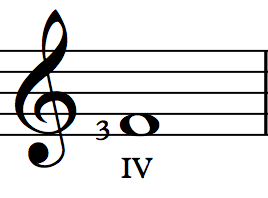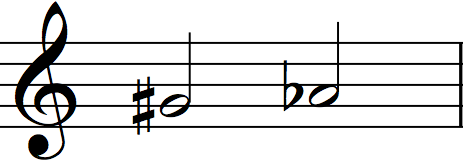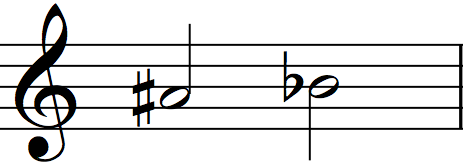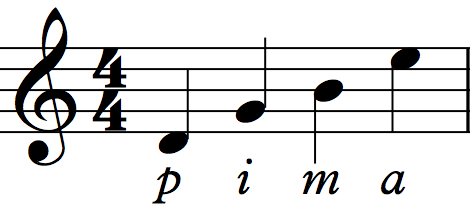12 More Notes, Repetition & Fingerings
INTRODUCTION
In this unit you will learn more fretted notes on the third string, symbols for small-scale repetition and fingerings.
NOTATIONS
Notes
The Notes ‘G♯’ & ‘A♭’
‘G♯’ and ‘A♭’ are enharmonics. To play ‘G♯’ or ‘A♭’, fret the first fret on the third string.
The Notes ‘A♯’ & ‘B♭’
‘A♯’ and ‘B♭’ are enharmonics. To play ‘A♯’ or ‘B♭’, fret the third fret on the third string.
Small-Scale Repetition
Simile

The simile means “in a similar way.” Sometimes it is seen in notation as the abbreviation sim. It directs you to continue playing in the manner previously marked. In the example below, the simile refers to the tenuto articulations.
One-Beat Repeat

The one-beat repeat is a diagonal line placed in the middle of the staff. It directs you to repeat the music from the preceding beat. It is important to mention that this symbol is often employed in jazz and popular music and suggests that you strum according to style or personal taste.
One-Measure Repeat

The one-measure repeat consists of a diagonal line with a dot on either side that is placed in the middle of an empty measure. It directs you to repeat the music from the preceding measure.
Two-Measure Repeat
The two-measure repeat consists of two diagonal lines with dots on either side that is placed on the barline between two empty measures. It directs you to play the music from the two preceding measures.
Four-Measure Repeat

The four-measure repeat consists of four diagonal lines with dots on either side that is placed on the barline between four empty measures. It directs you to play the music from the four preceding measures.
Fingerings
Fingerings specify which fingers to use and where to place them. The plucking-hand and fretting-hand each have a unique set of symbols.
Plucking-Hand Fingering
The plucking-hand fingering convention is universal. Each italicized letter corresponds with a Spanish word for a specific finger (with the exception of the pinky finger). See the example below.
| Symbol | Spanish | English |
| p | pulgar | thumb |
| i | indicio | index |
| m | medio | middle |
| a |
annular | ring |
| e or x | pinky |
Fretting-Hand Fingering
The fretting-hand fingering convention is more complicated because it can involve up to three extra symbols per note. Fingerings can easily clutter the score with too much visual information, which is why I recommend playing from scores in which composers or editors apply fingering notations sparingly. Two fretting-hand fingering conventions are explained in this unit: the standard method and Norman method (named for its inventor, Theodore Norman). Both methods use Arabic numerals to represent fretting-fingers.
| Symbol | Finger |
| 1 | index |
| 2 | middle |
| 3 | ring |
| 4 | pinky |
The Standard Method
In the standard method, Arabic numbers (without circles) represent fretting fingers; circled Arabic numbers represent string numbers; and Roman numerals represent fret numbers. See the example of the standard method below.
| Symbol | Direction | |
| Arabic number 3 | Fretting finger | |
| Circled Arabic number 3 | String number | |
| Roman numeral IV | Fret number |
The Norman Method
In the Norman method, Arabic numbers (without circles) represent fretting fingers and Roman numerals represent string numbers. Fret numbers are typically not employed in the Norman method because there is only one place per string where a note of the same staff position can be played. Therefore, if you are given the string number you can determine the suggested fret number on your own. See the example of the Norman method below.

| Symbol | Direction | |
| Arabic number 3 | Fretting finger | |
| Roman numeral IV | String number |
Why the Norman Method?
I believe the Norman method is more effective than the standard method at reducing the amount of visual information on the score. It also fosters an intuitive approach to sight-reading. However, because the standard method is more common, it will be applied to most compositions and exercises throughout the series.
Let’s Play |
Sight-Reading Tip
If the score you intend to sight-read contains a lot of fingerings, do not feel inclined to follow them at first. More often than not, an editor (not a composer) adds fingerings to a score as helpful suggestions. In this case, the editor’s fingerings are not mandatory. However, sometimes a composer will assign fingerings in order to achieve a particular timbre or phrasing. In this case, fingerings provide deeper insight into a composer’s musical intentions. In either case, fingerings do not need to factor into a first or second sight-reading encounter. Remember, too much visual information on the page can slow down mental processing.
Checklist for Sight-Reading
- Count the beats out loud (including the &).
- Keep going (even if you make a mistake).
- Maintain your best playing posture.
- Look at the score, not your hands.
- Play with the feel of the meter.
- Play patterns instead of individual notes (AKA chunk).
- Cultivate a calm demeanor.
- Have fun!
Let’s Play Rhythms |
Attitude Tip
Don’t think; feel! It is like a finger pointing away to the moon. Don’t concentrate on the finger or you will miss all that heavenly glory. –Bruce Lee in Enter the Dragon
Exercise 12.1: Score
Exercise 12.1: Audio
Exercise 12.2: Score
Exercise 12.2: Audio
Exercise 12.3: Score
Exercise 12.3: Audio
Exercise 12.4: Score
Exercise 12.4: Audio
Let’s Play Patterns |
Attitude Tip
Treat every moment as your last. It is not preparation for something else. –Shunryu Suzuki
Remember, Roman numerals represent string numbers.
Exercise 12.5: Score
Exercise 12.5: Audio
In the next exercise, the simile in measure 3 directs you to continue accenting in the manner of measures 1 and 2.
Exercise 12.6: Score
Exercise 12.6: Audio
Exercise 12.7: Score
Exercise 12.7: Audio
Let’s Play Duets |
Attitude Tip
When I let go of what I am, I become what I might be. –Lao Tzu
from Sul Margin d’un Rio by Niccolò Paganini: Score
Sul Margin d’un Rio: Audio
Let’s Play Compositions |
These compositions are under the Creative Commons Attribution-NonCommercial 4.0 International License (CC BY-NC 4.0).
Attitude Tip
A ship in harbor is safe, but that is not what ships were built for. –John A. Shedd
The piece below provides two sight-reading opportunities. I suggest you sight-read the Guitar 1 melody first and the vocal melody second.
Texas by Brandon Mayer: Score
Texas: Audio
Melpomene by Paweł Kuźma: Score
Melpomene: Audio
Congratulations!
You have completed this unit! If you kept up with the beat and accurately played approximately 70% of the pitches and rhythms, you are ready for the next unit. Feel free to repeat the exercises. However, do not play them so often that you memorize them. Once you memorize the notation, you are no longer developing the skill of sight-reading.






